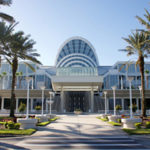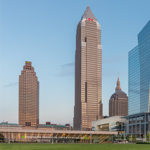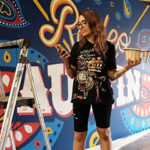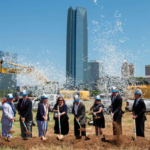
In our July issue cover story — “The Inside-Out Convention Center” — Senior Editor Barbara Palmer explored how centers are increasingly being designed to include important features that cater to groups’ wellness and their desire for connectivity and flexibility in the way they use the space. In addition, these buildings are no longer walled-off to the larger community, but are part of the fabric of the cities they inhabit, engaging local residents and delegates alike.
The International Convention Centre Sydney (ICC Sydney), which is now under construction for a scheduled December 2016 debut, embodies this kind of design thinking. ICC Sydney’s lead architect — Ken Maher from architectural firm HASSELL + Populous — has contributed this post to explain how the center has been conceived to change the way Sydney will deliver business events while rejuvenating an important piece of its waterfront precinct.
The rapidly emerging ICC Sydney is the centrepiece of the AU$3.4 billion, 20-hectare transformation of Darling Harbour. The integrated team has used this development as an opportunity to instigate a new way of connecting this part of Sydney, developing a much more inclusive community experience for visitors and locals alike. The rejuvenation of the western side of the Sydney harbour area is also generating opportunities for the reinvigoration of the adjoining neighbourhoods. Here architecture, public realm design, and precinct integration will change the way business transacts as well as the way major, theatre-based entertainment events are experienced in our global city.
We know success for these projects is all about the quality of the experience. We know visitors enjoy the same experiences locals enjoy. We also recognise that people coming to conventions, exhibitions, and all manner of events will be here for a limited time and one of the best things we can offer them is the ability to capture the authentic flavour of the city during their visit.
We understand the value of interaction, collaboration, and connection. The most interesting parts of the city are the parts that are genuinely a mix of activities and uses; where people work, take leisure, live, and can have creative interactions and exchanges that drive the knowledge economy of the city.
Cities have an inherent structure connected via public places. In regenerating neglected precincts, if you create a robust public domain, street and park system that is connected into the broad structure of the city, you are able to provide more dynamic and authentic experiences for people. This was previously lacking in Darling Harbour, so we have re-introduced a permeable network with new links to the south and west that are integrated with light-rail stops.
The ICC Sydney development comprises three very specialist building types: a convention centre, an exhibition centre, and a large theatre. Each are designed to be as flexible as possible in order to take on a variety of programs, yet have the character and quality to attract people and engage in the life of the city.
These are undeniably big, important civic buildings. When designing this complex project and its key public spaces, rather than see it as one place alone, we looked at how we could strike a balance between expressing a recognizable identity of a united public precinct, whilst giving each venue its own personality particular architectural character that fluidly blends into the surrounding landscape. To achieve this we have drawn upon the beautiful surrounds of the public realm, uniting the three major venues through the continuity of the landform which acknowledges indigenous heritage.
The exhibition centre located in the south of the precinct has gutsy, urban, and robust architecture, in response to the celebratory nature of the city and its links to Chinatown, the universities, and the emergence of this amazing new digital creative precinct and its entrepreneurs.

In the centre, the theatre design amplifies the local landscape and folds into Tumbalong Park, which will continue to be a public venue for entertainment, relaxing, lunching in the open air, and a variety of events. Here the architecture is more intimate, warm, and gentle. The Event Deck of ICC Sydney, its exhibition halls and meeting-room pods relate directly to the park and the main boulevard. We have treated the terracing like tree canopies, developing a green roof and layered lands.
In the north, the convention centre is located at the edge of the harbour adjacent to the Woodward

Fountain. It is designed to reflect light and the sparkle of the water and is capped by a sculpted roof that celebrates the harbour and city beyond.
Adding to the successful existing playgrounds and retail outlets of Darling Quarter, the revitalisation of the area includes the development of new cafes and increased local engagement including public artwork displays and an ongoing precinct activation program that will celebrate a range of cultural events and links to ICC Sydney.
By restitching ICC Sydney and Darling Harbour back into the heart of the city, Chinatown, and Central Station, the precinct is firmly placed at the centre of Sydney’s robust knowledge economy.
This major transformation of an interesting and diverse part of central Sydney will provide a new place of activity and public amenity for residents, locals, and international visitors alike. New public connections to adjoining precincts will generate activation and creative opportunities for living and working. Importantly, state-of-the-art venues will become intrinsically part of the life of the city and its unique landscape.
Ken Maher is a leading Sydney-based architect and landscape architect. He is a HASSELL Fellow, a Life Fellow of the Australian Institute of Architects, and a Fellow of the Australian Institute of Landscape Architects. He is also Professor of Practice in the Built Environment Faculty at the University of New South Wales.




